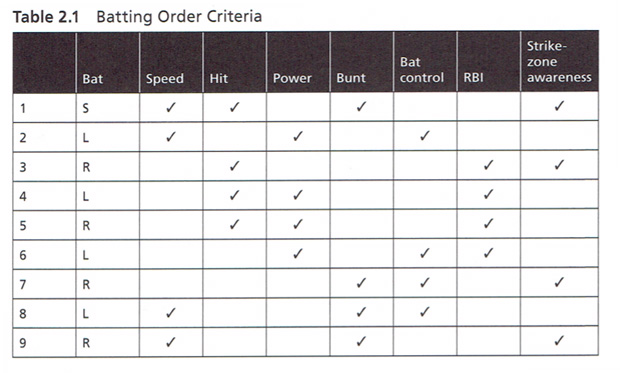| Assessing Your Personnel |
| By: Todd Guilliams
Originally Published in: High-Scoring Baseball Provided by: Human Kinetics After assessing players' ability level, coaches can start to place players into groups with similar skill levels. For example, creating two groups with names such as "deer" for the speed group and "buffalo" for the slower group can be a way for coaches to divide their players based on their running speed. This method is useful because it can help with planning practice. For example, the coach may decide to spend more time with the deer on straight steals, whereas the buffalo would work on delay steals. Another example would be for the deer to work on stealing third, while the buffalo spend time on recognizing and reacting to balls in the dirt. The buffalo need to key in on lateral movement to advance to third on a dirt ball. This key will help them avoid being thrown out on a ball that kicks just in front of the catcher. Dirt ball reads are critical for the buffalo group because they provide opportunities for base runners to get to third without straight stealing. Another way to target the training for the deer and buffalo is for deer to spend more time bunting while buffalo spend more time hitting. The deer, because they can run, should spend more time on bat-control skills such as the hit-and-run, whereas the buffalo should spend more time on driving in runs and hitting with men in scoring position. Putting a label on players is a way for them to take pride in their skill set, and it reinforces how they can contribute to a high-scoring offense. DEER Straight Steal Drag and push bunts Hit-and-run Get 'em over Safety squeeze (runner at third) BUFFALO Delay steal Sacrifice bunt Hit-and-run drive Drive 'em over Fly ball with the infield in BATTING ORDER The ultimate batting order would consist of power, speed, bat control, proper mental approach, and a blend of left-handed and right-handed batters. Here is a look at some of the criteria for each person in the batting order: Leadoff Batter The leadoff batter should possess outstanding strike-zone discipline, speed, and baserunning instincts and be one of your two best over-all hitters. You want your leadoff hitter to be an exceptional hitter because he will usually get one extra at-bat per game. The leadoff batter must be able to hit above-average velocity so that he can handle the opposing team's closer. He must also be able to make a statement that he can handle the starting pitcher's best fastball when starting the game. His success will give his teammates a confidence boost and make the pitcher doubt the quality of his fastball. For argument's sake let's say that our leadoff batter bats right-handed. Two Hole The two-hole hitter is the most under-appreciated batter in the lineup. Most ballclubs make the mistake of putting a hitter in the two hole who is predominately a bat-control hitter but not an outstanding pure hitter. A high-scoring offense needs to have a two-hole hitter who defines the offense, meaning that he can not only handle the bat but also strike fear in the other team because he has at least gap-to-gap power, if not home run power. If your team has a two-hole hitter who is a move-the-runner guy and you're hoping that he can just bunt and draw an occasional walk, keep in mind that your opponent's pitching staff will dominate that hitter, especially late in the ballgame, because he will be challenged in the strike zone and the corners will play up, negating the bunt. He will be forced to swing the bat to earn his way onto base. In our ideal lineup, the two-hole hitter will bat left-handed and be able to take advantage of the hole on the right side created when our leadoff batter gets on base. Three Hole The three-hole position is usually reserved for your best line-drive hitter. But the three-hole hitter does not have to be your best RBI producer. The four-hole hitter will have more RBI opportunities than the three-hole hitter. The third batter should possess good strike-zone discipline because he will be pitched tough in RBI situations. He must learn to swing at pitches in his zone and not chase pitches outside the strike zone. It is advantageous for the third hitter to draw walks because that puts him on base for your RBI producers—the hitters in the four, five, and six slots. Again, alternating batters is advantageous for your high-scoring offense, so we want the third batter to hit from the opposite side of the fourth batter. Cleanup The four-hole hitter is someone who possesses power, is a great RBI producer, and essentially is a hitter who is feared. The four-hole hitter is the cornerstone of the offense. When placing personnel in a batting order the ideal place to start is with the four-hole hitter. A batter with 90-plus bat speed and a line-drive up stroke with a great approach would fit the profile. If the three-hole hitter bats right-handed, the four-hole hitter would ideally bat left-handed and vice versa. Five Hole The five-hole hitter's job is to drive in runs. Although he may not possess the best strike-zone discipline, he can make up for that with aggressiveness and an ability to drive balls to the gaps. The ideal five-hole hitter is different from the four-hole hitter in terms of his ability to handle the bat. For example, if the four-hole hitter has excellent strike-zone discipline, having a five-hole hitter who occasionally chases pitches would be acceptable. But if the four-hole hitter is vulnerable to a right-handed breaking ball, the ideal five-hole hitter would be able to handle that pitch. If both hitters have the same issue, it becomes too easy for the opposing pitcher to strike out both hitters in critical RBI situations. Six Hole The sixth batter is similar to the fifth batter in that both can drive in runs, but the six-hole hitter strikes out more often than the four and five hitters. In a perfect world he would possess at least gap-to-gap power and have different strengths and weaknesses than the fifth batter. If the five-hole batter hits right-handed, the ideal six-hole hitter would bat left-handed. Alternating hitters really challenges the opposing pitcher to command all his pitches in all quadrants of the strike zone, and he cannot get into easy patterns of striking out similar batters. For example, a predominantly right-handed lineup facing a right-handed pitcher with a good slider who can locate that pitch on the outer half of the plate will likely struggle because pitches are breaking sharply away from them. Without left-handed hitting, an offense has nothing to counteract that pitch and force the pitcher to do something different. Seven Hole The seven-hole batter would be a good spot for a leadoff-type hitter, someone who possesses speed but is not quite as good a hitter as the leadoff batter. He knows how to run the bases and can set the table for the bottom of the lineup. He does not have to possess power, but ideally he can steal a base and help propel himself around the bases. This batter would bat right-handed in the ideal batting lineup. Eight and Nine The last two spots in the batting order are reserved for the weakest hitters in terms of their ability to hit for average. These two hitters should be proficient in their ability to get a bunt down and execute bat-control skills such as a hit-and-run. The eight and nine hitters probably play critical defensive positions such as shortstop, second base, center field, or catcher. Ideally, the last two batters should bat from opposite sides. If the hitters are similar, the preference would be for the nine-hole batter to be the better runner because after the lineup flips to the top, the nine-hole hitter might be able to steal a base, go first to third, and score from first base on a ball hit into the gap. Table 2.1 shows the ultimate batting lineup and the ideal skill sets to field a diverse and well-rounded starting nine. We have seven offensive skills to work with, and we've limited the model to just three or four skills for each of the nine hitters. The more talented your ballclub is, the more skills your players are going to bring to the table-and vice versa.
|








